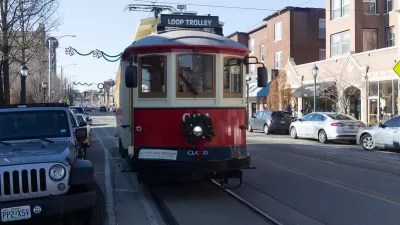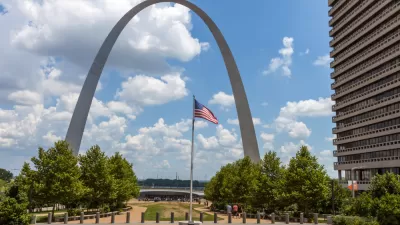The centerpiece of a $500 million plan for redeveloping New Orleans' riverfront is an 'iconic' sculpture, replacing the empty World Trade Center tower. Roberta Brandes Gratz argues the city should focus on small steps instead of a tourism boondoggle.
"In his mid-April rollout of a sweeping plan to redevelop the downtown riverfront, Mayor Mitch Landrieu spoke excitedly of replacing the World Trade Center at the foot of Canal Street with a monumental tourist attraction — something, he said, on a par with the Gateway Arch in St. Louis," writes Gratz. "A bit of education might dissuade the mayor from collapsing into the arms of that old-time and now thoroughly discredited style of 'urban renewal.'”
In the ensuing opinion piece, she provides a cautionary tale of the unfulfilled economic promises delivered by the St. Louis landmark, and describes the lessons for New Orleans.
"First, New Orleans does not need an iconic sculpture on the waterfront, even assuming it could land one as beautiful as Saarinen’s arch," she argues. "The French Quarter and the larger city itself are all the iconic attraction the city needs. No other American city has what New Orleans already has, having evolved organically, the only way authentic cities grow."
"[W]hile advocates of big projects focus on outsized, misguided visions, New Orleans is rebounding incrementally through innovative efforts all over town, proving once again that small and modest projects always exceed expectations while the big ones never fulfill theirs."
FULL STORY: Monumental mistake: Demolishing World Trade Center to build a tourist attraction

Study: Maui’s Plan to Convert Vacation Rentals to Long-Term Housing Could Cause Nearly $1 Billion Economic Loss
The plan would reduce visitor accommodation by 25,% resulting in 1,900 jobs lost.

North Texas Transit Leaders Tout Benefits of TOD for Growing Region
At a summit focused on transit-oriented development, policymakers discussed how North Texas’ expanded light rail system can serve as a tool for economic growth.

Why Should We Subsidize Public Transportation?
Many public transit agencies face financial stress due to rising costs, declining fare revenue, and declining subsidies. Transit advocates must provide a strong business case for increasing public transit funding.

How to Make US Trains Faster
Changes to boarding platforms and a switch to electric trains could improve U.S. passenger rail service without the added cost of high-speed rail.

Columbia’s Revitalized ‘Loop’ Is a Hub for Local Entrepreneurs
A focus on small businesses is helping a commercial corridor in Columbia, Missouri thrive.

Invasive Insect Threatens Minnesota’s Ash Forests
The Emerald Ash Borer is a rapidly spreading invasive pest threatening Minnesota’s ash trees, and homeowners are encouraged to plant diverse replacement species, avoid moving ash firewood, and monitor for signs of infestation.
Urban Design for Planners 1: Software Tools
This six-course series explores essential urban design concepts using open source software and equips planners with the tools they need to participate fully in the urban design process.
Planning for Universal Design
Learn the tools for implementing Universal Design in planning regulations.
City of Santa Clarita
Ascent Environmental
Institute for Housing and Urban Development Studies (IHS)
City of Grandview
Harvard GSD Executive Education
Toledo-Lucas County Plan Commissions
Salt Lake City
NYU Wagner Graduate School of Public Service





























